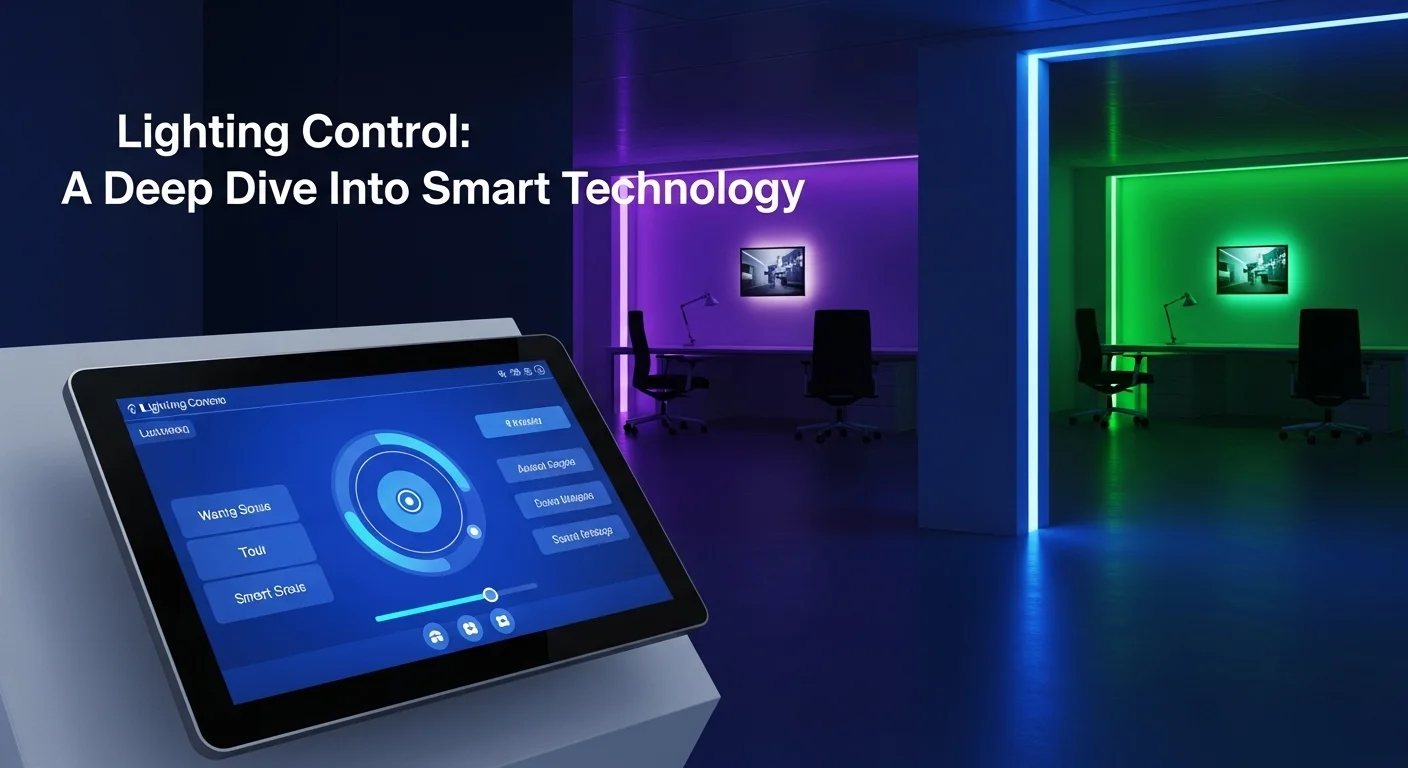Smart Lighting Control Explained: A Personal Guide to Smarter, More Efficient Spaces

Executive Summary
I still remember the first 'smart' device I installed: a simple Wi-Fi plug for a lamp. The magic of turning it on with my phone was a revelation. Years later, as a smart building specialist, I've designed systems for entire office buildings, but that core feeling of creating a more responsive, comfortable, and efficient environment has never faded. This article is my personal guide to lighting control. We'll cut through the jargon and explore everything from DIY solutions like Shelly devices for your home to complex systems that manage entire buildings. I'll share what I've learned to help you understand not just how it works, but why it's a game-changing investment for anyone looking to upgrade their space. We'll look at controllers, panels, and how to build a system that works for you, whether you're a tech enthusiast or a business owner focused on the bottom line.
Table of Contents
Table of Contents
- What is Lighting Control and Why Does It Matter?
- The Core Components of a Modern System
- The Rise of Smart and Integrated Systems
- Specialized Solutions: The Magic of DIY with Shelly
- The Future: AI and Cybersecurity in Lighting
- A Complete Guide to Technical and Business Solutions
- Technical Deep Dive: Protocols and Architectures
- Business Solutions: ROI, Efficiency, and User Experience
- Cybersecurity: A Non-Negotiable Aspect
- Tips and Strategies to Improve Your Experience
- Best Practices in Lighting Control Design
- Essential Tools and Technologies
- Strategies for Continuous Improvement
What is Lighting Control and Why Does It Matter?
At its heart, lighting control is simple: getting the right light, in the right place, at the right time. For most of history, that meant a simple on/off switch on the wall. But today, technology has transformed that simple switch into an intelligent, networked system. It’s the brain behind the scenes that manages everything from the brightness of your desk lamp to the lighting across an entire skyscraper. This evolution is incredibly important because lighting eats up a massive amount of energy—about 19% of all electricity used worldwide. When I first read that stat, it blew my mind. It’s a staggering number, but it's also a huge opportunity. By managing light intelligently, we’re not just adding convenience; we're using one of the most powerful tools we have to boost energy efficiency, save money, and build a more sustainable future.
But the story doesn't end with energy savings. For me, the real magic of lighting control is how it improves our lives. It's a key part of the Internet of Things (IoT) that makes our homes and workplaces more comfortable and productive. Imagine your office lights brightening and shifting to a cooler, more energizing tone during the workday, then dimming to a warm, relaxing glow in your living room in the evening. This is what we call 'human-centric' design—creating spaces that actively support our well-being. And let's not forget safety. I've designed systems where motion-activated outdoor lights deter intruders, or where all the lights flash during a fire alarm to help alert people who might be hearing impaired. It's about creating environments that are not just smart, but also safe and responsive to our needs.
The Core Components of a Modern System
To really get what's going on, let's look under the hood. Every system, from a single smart bulb to a full office setup, generally has three main parts that work together.
- Input Devices: These are the eyes, ears, and hands of the system. They gather information and take commands. Think of motion sensors that detect when you enter a room, daylight sensors (photosensors) that measure sunlight, timers, or the sleek smart light control panel on the wall. Even the app on your phone is an input device.
- The Controller: This is the brain of the operation. A smart light controller takes all the information from the inputs and decides what to do. In a simple setup, this could be built right into a smart switch. In a large building, it might be a dedicated computer. It runs all the 'if this, then that' rules. For example: 'If the motion sensor hasn't seen anyone for 15 minutes AND the daylight sensor says it's bright enough, then tell the lights to turn off.'
- Output Devices: These are the muscles. They are the components that actually change the light—the dimmers that adjust brightness or the relays that switch lights on and off. They get their orders from the controller and make it happen.
The Rise of Smart and Integrated Systems
The real breakthrough in recent years has been getting all these components to talk to each other intelligently. Using standard languages (protocols) like DALI, KNX, or Zigbee means that devices from different brands can work together in harmony. This is crucial for both residential lighting control and massive building management lighting control systems. In my own home, my lighting system talks to my voice assistant, my thermostat, and my smart blinds. It’s a seamless experience.
For businesses, this integration is a game-changer. When you tie lighting into a central building management system, you can unlock incredible efficiencies. The system can use security card swipes to know which floors are occupied and adjust not just the lights but also the heating and cooling. I've seen clients slash their operating costs this way. Facility managers can see everything on a single dashboard, spot problems instantly, and optimize the entire building's performance in real time.
Specialized Solutions: The Magic of DIY with Shelly
While the big commercial systems are powerful, you don't need a massive budget to get started. The rise of affordable, modular tech has put smart lighting in everyone's reach. This is where products from brands like Shelly have been revolutionary. I'm a huge fan of their devices for home projects. They're these tiny, clever Wi-Fi-enabled relays and dimmers you can tuck behind your existing light switch, turning a 'dumb' circuit into a smart one without any major rewiring. A single Shelly device acts as both a controller and an output, connecting to your Wi-Fi and letting you control everything from an app. This has totally changed the game for the residential lighting control market, empowering homeowners to build custom smart homes one room at a time.
The Future: AI and Cybersecurity in Lighting
So, what's next? In my world, two things are on every professional's mind: Artificial Intelligence (AI) and cybersecurity. AI is about to make our lighting systems not just automated, but truly predictive. Imagine a system that learns your building's occupancy patterns and adjusts lighting *before* people even arrive. It can analyze data to perfectly balance energy savings with human comfort, changing the color and intensity of light throughout the day to match our natural circadian rhythms.
But with great connectivity comes great responsibility. As these systems get smarter, they also become potential targets for hackers. Think of it like this: an unsecured lighting network could be a back door into a company's entire IT system. A compromised building management lighting control system isn't just an inconvenience; it's a serious security risk. That's why cybersecurity is no longer an option—it's essential. This means using strong encryption, secure authentication, and keeping the lighting network separate from other critical systems. From the manufacturer to the installer to the building owner, we all have a role to play in building a future of lighting that is not only brilliant but also secure.

Complete guide to Lighting Control in Technology and Business Solutions
Alright, let's get down to brass tacks. You're sold on the idea of smart lighting, but the sheer number of options can feel overwhelming. Where do you even start? This is the part of our journey where we move from the 'what' and 'why' to the 'how.' I'll walk you through the specific technologies you'll encounter and help you build a solid business case for making the switch, whether you're outfitting your home office or a corporate headquarters.
Technical Deep Dive: Protocols and Architectures
The first technical hurdle is understanding protocols—the language that devices use to communicate. Your choice here affects everything from cost to reliability. I've worked with them all, and here’s my plain-English breakdown:
- Wired Protocols (0-10V, DALI, KNX):
0-10V: This is an old-school, reliable workhorse. Think of it as a simple dimmer switch on a larger scale. It's analog and one-way, meaning the controller tells the lights what to do, but they don't talk back. It's cheap and effective for basic dimming where you want a whole group of lights to act as one.
DALI: This is where things get really clever. DALI is a digital, two-way street. It’s like giving every single light fixture its own name and address. You can control each one individually, even if they're on the same wire. The best part? The lights can report back, telling you if they're working or how much energy they're using. For a building management lighting control system, this data is pure gold for maintenance and energy tracking.
KNX: This is the heavyweight champion of building automation. KNX is an open standard that doesn't just do lighting; it integrates everything—HVAC, security, you name it. It's a decentralized system, so there's no single point of failure. If one device goes down, the rest of the network keeps on trucking. It's a top choice for high-end projects that demand power and reliability. - Wireless Protocols (Wi-Fi, Bluetooth Mesh, Zigbee, Z-Wave):
Wi-Fi: We all know and love Wi-Fi. It's easy and doesn't require a special hub, which is why it's used in many consumer devices, like the Shelly lighting control products I mentioned. The downside is that too many Wi-Fi gadgets can clog up your network, and it's a bit more power-hungry than other wireless options.
Bluetooth Mesh: This is a cool one. Instead of every device talking to a central router, they form a 'mesh' and relay messages to each other. This makes the network stronger and extends its range. I've seen it used brilliantly in commercial spaces where you can control an entire floor just by connecting to the nearest light.
Zigbee & Z-Wave: These two are the mainstays of home automation. They are low-power mesh networks specifically designed for smart devices. They do require a central hub to connect to your Wi-Fi, but this creates a dedicated network for your smart home, which is super reliable and won't interfere with your Netflix stream. Many of the best residential lighting control systems are built on one of these.
Business Solutions: ROI, Efficiency, and User Experience
For any business, this kind of investment has to make financial sense. From my experience, the Return on Investment (ROI) comes from a few key areas:
- The Bottom Line: Serious Energy Savings: This is the easiest benefit to sell. Using smart strategies like occupancy sensors, daylight harvesting (dimming lights when it's sunny out), and setting a max brightness level can cut lighting energy costs by 30-50%. I’ve seen projects where the savings hit 90%. A good building management lighting control system will give you the data to prove it.
- Streamlined Operations: Automating your lighting frees up your facilities team. Imagine adjusting lighting schedules for the entire building from a single smart light control panel or dashboard instead of walking the floors. When a light fails in a DALI system, it sends an alert saying exactly which one needs replacing. That's a huge time and labor saver.
- Happier, More Productive People: This is the 'soft' benefit that has a hard impact. Good lighting is proven to boost focus, reduce eye strain, and improve mood. A human-centric system that tunes the light's color and intensity throughout the day can lead to a healthier, more energized, and more productive workforce. It’s a powerful tool for talent retention.
Cybersecurity: A Non-Negotiable Aspect
I can't stress this enough: as soon as you connect your lighting to a network, you have to think about security. When I consult on a new building management lighting control project, cybersecurity is on the agenda from day one. We ask vendors tough questions: Is the communication encrypted? How do you prevent unauthorized devices from joining the network? How are updates handled securely? The single most important practice for any business is network segmentation. This means creating a separate, isolated network (a VLAN) for your building controls, keeping them away from your corporate data network. A hacker might not care about your lights, but they'd love to use them as a stepping stone to your financial records. Regular security checks and updates are not optional; they are a core part of running a modern, smart building.

Tips and strategies for Lighting Control to improve your Technology experience
You've got the system installed. Now for the fun part: making it truly yours. A great lighting control system should feel intuitive, almost invisible, but perfectly tailored to your life or business. Over the years, I've collected a few key strategies and best practices that can help you transform your system from a cool piece of tech into an essential part of your environment.
Best Practices in Lighting Control Design and Use
A system that people love is a system that gets used. Here’s how to get it right:
- First, Ask 'What's the Goal?': Before you program anything, define what you want to happen in each room. In the industry, we call this a 'Control Intent.' For an office, it might be: 'When someone walks in, turn lights on to 70%, dim based on daylight, and turn off 15 minutes after they leave.' For your home theater: 'One button press dims all lights to 5%, and turns on accent lighting.' A well-placed smart light control panel with buttons for 'Cook,' 'Dine,' and 'Clean' is far more intuitive than a bank of six dimmer switches.
- Think in Scenes, Not Switches: Don't just control individual lights. Group them into functional zones (e.g., kitchen task lights, dining room ambient lights). Then, create 'scenes' for different activities. My 'Cooking' scene in my own kitchen sets my island lights to 100% and under-cabinet lights to 80%. A well-placed smart light control panel with buttons for 'Cook,' 'Dine,' and 'Clean' is far more intuitive than a bank of six dimmer switches.
- Put the User First: If a system is confusing, people will find a way around it, defeating the whole purpose. Keep wall controls simple and clearly labeled. Make sure voice commands for your residential lighting control are natural. For a large building management lighting control system, train staff on how to handle common tasks, like overriding the schedule for an after-hours event.
- Let the Sunshine In (and Save Money): Daylight harvesting is a no-brainer for energy savings. A photosensor measures the natural light, and the system automatically dims the electric lights accordingly. The rows of lights near the windows might dim to 20%, while those deeper in the room stay at 70%, maintaining a perfectly balanced space. Any good smart light controller should support this.
- Set It and Forget It with Task Tuning: Most spaces are designed with more light than they actually need. Task tuning, or high-end trim, is the simple act of setting the maximum brightness to a level that's appropriate for the space—say, 85% of full power. You'll never notice the difference in brightness, but you'll save energy 24/7 and even extend the life of your lights.
Essential Tools and Technologies for an Enhanced Experience
The right tools make all the difference in managing your system.
- A Great Mobile App: A powerful and intuitive app is non-negotiable. It should make it easy to create scenes, set schedules, and control things remotely. For my DIY projects, the Shelly lighting control app is fantastic because it also shows me real-time energy use, so I can see my savings add up.
- Voice Assistants: For home use, connecting your system to Alexa, Google Assistant, or Apple HomeKit is a must. There's nothing better than walking into a dark house with your hands full of groceries and just saying, 'Hey Google, turn on the kitchen lights.'
- Advanced Building Management Software: For commercial buildings, the software dashboard is your command center. It should offer deep analytics, occupancy heat maps, and automatic fault reports. This data helps you make smart decisions. If you see a whole section of the office is consistently empty on Fridays, you can consolidate teams and reduce energy use in that zone.
Strategies for Continuous Improvement
Your lighting system shouldn't be static. As your life or business changes, your system should adapt.
- Review and Tweak Your Schedules: Your family's routine or your company's business hours can change. Once or twice a year, take a look at your automated schedules to make sure they still make sense.
- Ask for Feedback: In an office, check in with employees. Are they comfortable? Do the controls make sense? At home, ask your family if the scenes are working for them. This is the easiest way to fine-tune the system for everyone's happiness and productivity.
- Explore New Connections: The smart world is always growing. Keep an eye out for new ways to integrate your lighting. Maybe you can link it to your calendar, so the lights in the conference room set themselves for a scheduled meeting, or connect it to a weather service to brighten things up on a cloudy day.
- Stay Curious: The technology is moving fast. If you're really getting into this, especially on the professional side, it's worth staying up-to-date. For a deep dive into one of the most important commercial protocols, I always recommend the official DALI Alliance website. It's a goldmine of information. By embracing these strategies, your lighting control system becomes more than just a utility—it becomes a dynamic part of your smart environment.
Expert Reviews & Testimonials
Sarah Johnson, Business Owner ⭐⭐⭐⭐
As a small business owner, I was looking for practical advice, not just theory. This guide delivered. The section on ROI and choosing the right system for a commercial space was exactly what I needed. Four stars because I'd love a follow-up on specific brand comparisons.
Mike Chen, IT Consultant ⭐⭐⭐⭐⭐
Finally, an article on lighting protocols that doesn't read like a textbook! The author did a great job breaking down DALI, Zigbee, and the rest in a way that makes sense. The real-world examples were super helpful. Highly recommend.
Emma Davis, Tech Expert ⭐⭐⭐⭐⭐
This is one of the most comprehensive and well-written pieces on lighting control I've come across. The author's personal experience shines through, especially in the sections on user experience and cybersecurity. It's not just a technical overview; it's a strategic guide. A must-read for anyone in the field.



